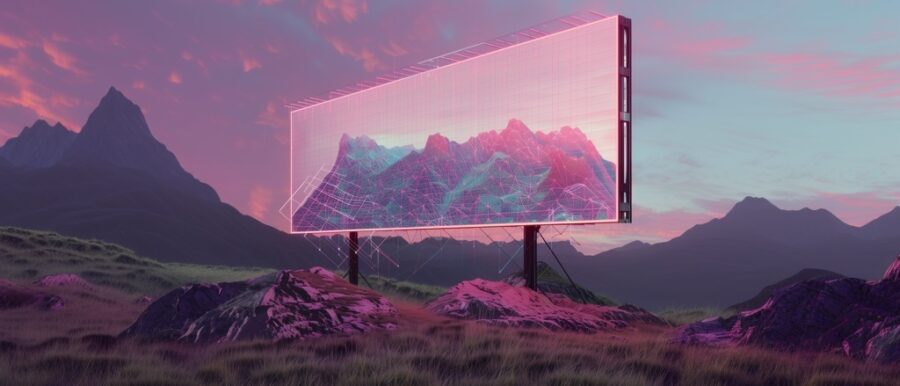
Learn about augmented reality (AR) advertising from some of the biggest brands in the world, and get practical advice on creating AR ads with our simple guide for brands.
This article was originally published by Arprio. Looking to learn more about immersive technology? Arprio helps companies navigate the XR space, launch new products, and grow their market share. Get in touch with Arprio now to learn more about how they can help.
Augmented reality (AR) allows brands to cut through the noise in ways that traditional media simply can’t. With a predicted global AR user base of 1.73 billion by the end of 2024, AR is still yet to reach its apex in terms of usage and potential advertising reach. At the same time, major social platforms like Snapchat continue to expand their AR ads offering with the recent launch of sponsored AR filters. Despite all this, some brands are still choosing to overlook AR advertising in favor of more familiar terrain.
To help address this, we’ve put together a quick guide covering what AR advertising is, some of the main AR platforms that you should be aware of, recent examples of great AR campaigns, and a step by step approach to help you plan your own AR campaign.
What is Augmented Reality Advertising?
Augmented reality advertising involves creating marketing campaigns or experiences using AR technology, which enhance the user’s view of the real world with digital content including graphics, text, or video. As we explained in The Difference Between VR, AR, MR and XR, the potential upside of AR in terms of recall and engagement is huge compared to traditional advertising formats, and can be enjoyed by basically anyone with a working smartphone. In that respect, AR advertising is unique compared to other immersive technologies, since it doesn’t rely on consumers owning any additional hardware. Furthermore, with the release of paradigm-changing tech like the Apple Vision Pro earlier this year, AR advertising also offers new opportunities in highly engaged and well-off consumer demographics who do have the means to invest in expensive hardware.
10 Great Examples of AR Advertising
AR advertising comes in all shapes and sizes, with AR building on a number of traditional advertising formats. While mediums like Out Of Home (OOH) are an obvious choice for augmented reality (thanks to the widespread adoption of QR codes during the pandemic), experiential and event-based marketing are also popular choices for brands looking to make a statement using AR. Similarly, AR tools that enhance a user’s buying journey – like Ikea’s Place app – are another great way to build trust and add value, without being obvious attempts at advertising. Here are a few of our favorite AR campaigns from recent years.
Pizza Hut – PAC-MAN AR (2021)
What was the fastest selling game console in the world? Based on the number of units sold, a pizza box. In 2021, Pizza Hut teamed up with creative development studio Tool and ad agency GSD&M to reimagine the iconic 80s arcade game PAC-MAN in an incredible AR campaign. Through an awesome combination of nostalgia and modern technology, Pizza Hut cooked up one of the best AR ad campaigns we’ve ever seen.
Using WebAR platform 8th Wall (owned by Niantic), Pizza Hut and their agencies gave customers a special pizza box that, when scanned with a smartphone camera, brought PAC-MAN to life in augmented reality right on top of the box via the phone’s web browser. With its accompanying Superbowl Ad, the campaign was a scorching success, racking up 741 million impressions, 10.6 million PAC-MAN pizza boxes sold, mainstream TV news coverage, plus countless PR plugs in outlets like Hypebeast, designboom, and Food & Wine.
Dune: Part Two (2024)
A simpler way to advertise with AR is through filters and lenses, which involve using a smartphone camera to blend elements of digital content into the viewed area, or elements of a user’s face into a digital scene. As part of their marketing push for the release of the long-awaited Dune: Part Two movie, Warner Bros created a Dune Lens for Snapchat that allowed users to become a sandworm-riding Fremen, the legendary desert warriors of Dune’s eponymous planet.
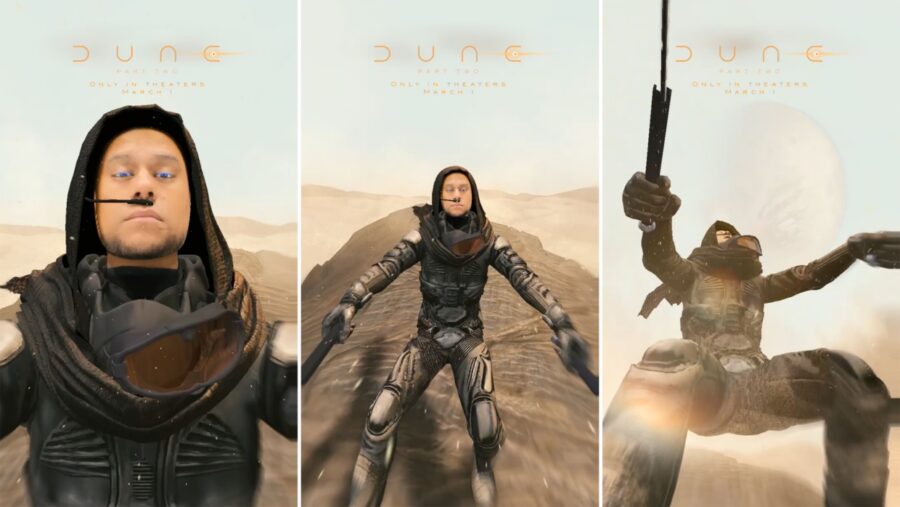
The lens and custom Cameo stickers ran alongside video ads for the film’s release, with Snapchat users able to tap the ads and purchase tickets from a microsite. The Dune AR campaign was a good example of a simple concept that could foster engagement and inspire user-generated content using AR, all while leading to an increase in ticket sales through the lens’ microsite.
Red Bull – World Series Cliff Diving (2023)
Energy drinks giant Red Bull are known for larger than life stunts and extreme sports, but consumers aren’t always able to appreciate the scale of their events without attending in person. AR agency Rock Paper Reality stepped in to help Red Bull solve this problem with an ingenious campaign promoting their World Series Cliff Diving. The campaign, a WebAR experience built on the 8th Wall platform, allowed users to experience what a 70ft dive looks like right from their smartphone by simply scanning a QR code. Breathtaking stuff!
Coca-Cola Zero – #TakeATasteNow (2023)
On September 25, 2023, Coca-Cola unveiled an OOH campaign that allowed users to change the ads’ 3D creative in real time using their smartphones. The #TakeATasteNow campaign, which ran across the UK for three weeks, let users grab a digital bottle of Coca-Cola Zero before getting a voucher to claim a real bottle in any participating Tesco store. This campaign is an example of an ‘Interaction-Reward’ style of AR experience that’s become hugely popular in B2C marketing.
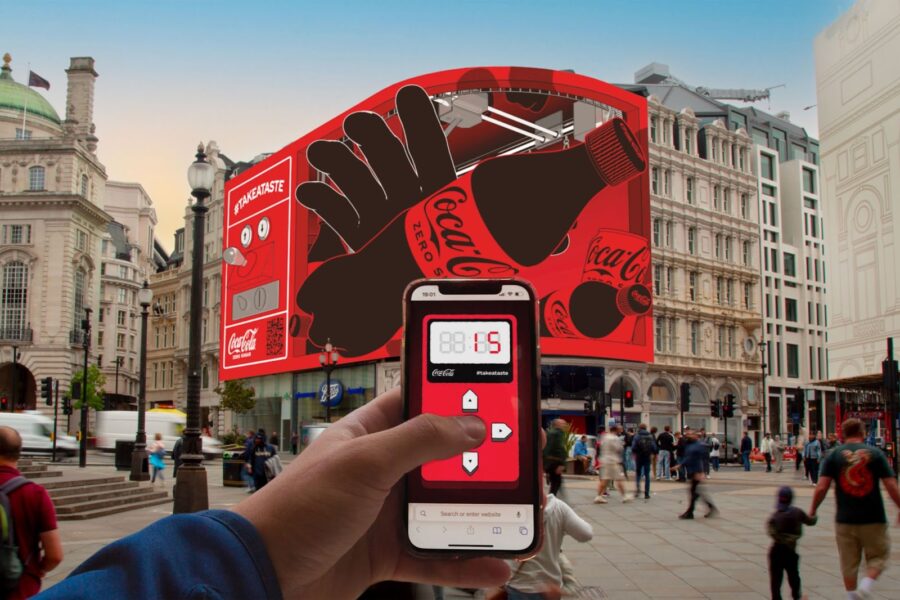
AR is a great way to gamify your advertising. As the Coca-Cola campaign shows, you can think of an AR ad as the start of a mini quest for your viewers, with the reward for engagement being some kind of real-life discount or free version of your product. If you want to take this approach further, check out some full-scale scavenger hunt style AR experiences like Adidas’ 2019 ComplexCon drop, which was a masterclass in building hype and engagement at an event using AR.
Burger King – ‘Burn That Ad’ (2019)
Set a McDonald’s ad on fire and get a free Whopper. That’s the basic concept for Burger King Brazil’s AR campaign, and it worked brilliantly. The creative agency behind the 2019 campaign, David Sao Paolo, sought to solve two crucial problems. First: that BK’s main rival in Brazil, McDonald’s, spent four times as much on paid media than they did, and second, that users weren’t really making the most of BK’s in-app purchases at the time. The solution? Create a way to boost in-app purchases while simultaneously piggybacking off the competition’s ads.
To achieve this, the team at David agency painstakingly collected every McDonald’s ad, including billboards, digital ad, tray papers, social media banners (even Google image searches!) to create a dynamic database that could then be used as tracking elements. When a user filmed any McDonald’s content in real life the BK AR experience would launch, with flames burning away the McDonald’s ad to reveal a free Whopper coupon, leading users straight to the BK app. Genius!
Top Gun: Maverick – AR Call Sign Generator (2022)
Designed to promote the release of the iconic Top Gun: Maverick (2022) movie, this call sign generator by creative studio Powster helped fans answer the immortal question for Top Gun fans everywhere: #WhatsMyCallSign. Using 8th Wall face-tracking, the filter placed holographic helmets on users and asked them a series of questions that resulted in a personalized call sign. The experience produced a shareable selfie with the user in their helmet, and users could also take the quiz on a dedicated website.
Localized for over 40 territories, Powster also created tailored versions for various brand partners like Showcase, Vue Entertainment, IMAX, Coke, and even Lady Gaga. The call sign generator helped create huge hype for the film on social media, and it was even picked up in a US TV interview featuring Jon Hamm!
Pepsi Max – ‘Unbelievable’ Bus Shelter (2015)
Perhaps one of the most viral advertising campaigns we’ve seen incorporate AR into a built environment is Pepsi Max’s iconic ‘Unbelievable’ bus shelter spot. The award-winning ad relied on cameras built into a bus shelter with a live feed of the street behind to create the illusion of asteroids falling, UFOs invading, and tentacles coming up from the pavement to grab unlucky passersby.
“In a world where nearly everyone has an AR-compatible device (ie smartphones) in their pockets at all times, brands have a valuable opportunity to enhance traditional OOH ad platforms, such as billboards and bus stops, with a technological twist. Adding to this opportunity is the fact that most people, as a result of having lived through the Covid-19 pandemic, are now intimately familiar with QR codes – one of the most common portals into AR experiences.” – Webb Wright, for The Drum
The experience, designed by Grand Visual, was one of the first viral instances of AR advertising, garnering millions of views and a huge sales bump for Pepsi Max in the month the ad ran. Ultimately, the experience highlights AR’s potential to radically enhance traditional OOH media with just a dash of imagination and ingenuity. After all, AR campaigns don’t need to be wildly complicated to make a big impact!
Ikea – Place App (2017)
‘Try before you buy’ is an obvious use case for AR that has been around for a number of years now, and it’s a great way to facilitate your customer journey. Released in 2017, Ikea’s Place app solved the simple problem of knowing how furniture would look in a space before you go ahead and buy it. Overall, the solution helps keep customers engaged in the buying journey, reduces return costs and lost revenue, all while giving Ikea an edge over their competitors.
Netflix – Open Anime AR Portal (2022)
To capitalize on the growing surge of mainstream interest in anime in the wake of shows like Attack On Titan and One Piece, Netflix created an immersive anime experience and microsites using 8th Wall’s image tracking capabilities. With the help of Powster and Hello Tello, Netflix’s Creative Labs worked to create beautiful immersive AR portals showcasing various anime themes. The portals, which were activated by QR codes on OOH and social ads worldwide, also came with stunning microsites with their own unique immersive adventures. Check them out at www.openanime.com
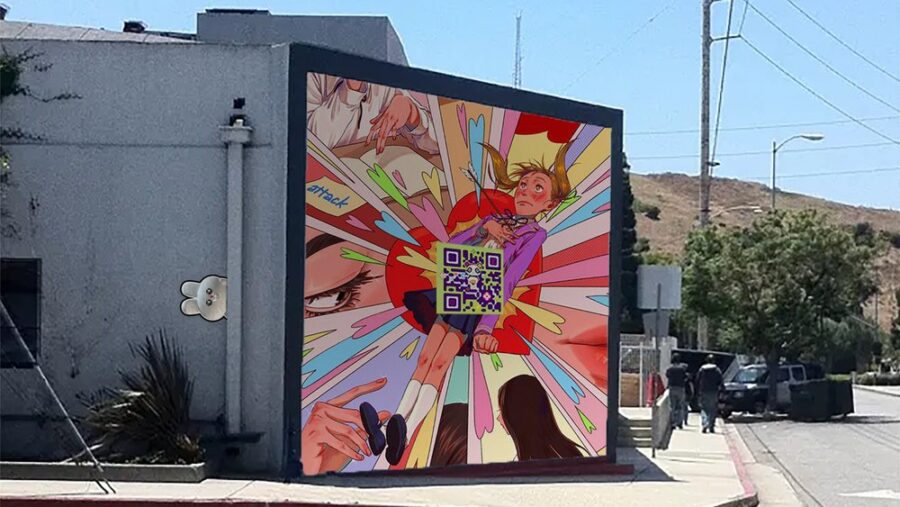
Circle K & Niantic – Pokémon Go Rewarded AR (2023)
Last year, convenience chain Circle K partnered with Pokémon Go developers Niantic to roll out a series of in-app AR ads. Utilizing Niantic’s AR platform, 8th Wall, Circle K was one of the first brands to pilot the new Rewarded AR ads within Pokémon Go. As part of the experience, players of the game were presented with an ad in the form of a floating balloon that took them to a giant Circle K coffee cup that they could interact with, which finally got them to visit a Circle K nearby to grab a coffee.
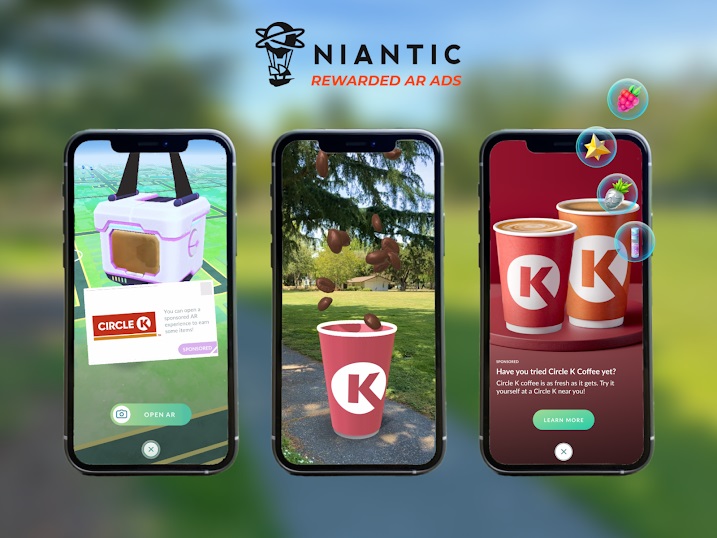
According to Marketing Dive, the campaign saw an average engagement rate of 76% and an average completion rate of 95%, highlighting the stickiness of AR ads compared to traditional formats. Ultimately, campaigns like Circle K’s pave the way for an explosion of similar experiences in popular AR spaces like Niantic’s flagship game, and challenge brands to come up with new and creative ways to captivate already engaged users in those worlds.
How to Create Branded AR Experiences in 2024
If you’re looking to capitalize on the power of AR advertising, here’s a step by step guide to help you get started. Whether you’re working solo on a small campaign and want to learn the basics, or you want to develop an AR experience as part of a bigger campaign, the following steps are designed to help you think more strategically about using AR in your next marketing campaign.
1. Pick your moment (and your medium)
Picking the right time and campaign to use AR is key. As we wrote in our latest post, How to Launch an XR Product, a launch event is a great time to show off a new product or kick off a new campaign using AR. Experiential marketing can be hugely enhanced by AR because of its immersiveness, user-interaction, and social sharing elements.
Similarly, certain mediums like packaging (Pizza Hut’s PAC-MAN boxes), billboards, or other OOH experiences (like Pepsi’s bus stop) lend themselves to AR. Alternatively, purely digital ads using filters (like Dune: Part Two) or specially-designed AR experiences (like Red Bull Cliff Diving) are also a great fit for AR campaigns.
There are also some important distinctions to make when deciding on your medium, particularly whether or not you want to do web-based AR (WebAR) experiences, and the level of coding you intend to do. Here are a few key mediums to be aware of:
WebAR
A major choice when developing an AR campaign is whether you want to create a dedicated AR app for your brand, or provide a browser-based experience instead. Creating an AR app, or even incorporating AR functionality into an existing branded app can be a good way to provide a more curated branding experience, but this might create undue friction for users who don’t want to download a new app.
A more straightforward way to reach customers is through WebAR, which allows you to provide your AR experiences directly from a web browser. Typically viewed through a smartphone, any user can scan a QR code and get straight into the action. A great example is the unique marketing approach of wine company 19 Crimes, who’ve created an engaging storytelling experience with all their wine bottles. All you have to do is scan one of their labels through their living wines AR experience website using your smartphone’s camera, and watch the characters on the bottle come to life.
8th Wall
Niantic’s 8th Wall platform is a major development platform for WebAR & WebVR. They offer a comprehensive solution for creating, publishing and distributing WebAR and WebVR content through their Cloud Editor, AR Engine, and Built-in Hosting options. They also have a ton of examples of recent WebAR campaigns on their website if you’re looking for inspiration!
No-code AR creation tools
Another important thing to keep in mind when developing any AR experience is your familiarity with coding. If you’re looking to build something more complex, and don’t have the resources in-house, outsourcing your work to a creative studio who specialise in AR assets might be your best bet (particularly if you want to publish something using 8th Wall’s development suite, which is geared more towards developers).
However, there are a number of no-code platforms out there that you can utilise for AR as well, like Zappar, Blippar and Geenee, who all offer various different templated AR experiences and assets that can be easily modified to suit a number of business cases and marketing goals.
2. Decide on your AR marketing goals
Choosing your goals is a standard part of every marketing campaign, and it’s no different with AR. What do you want people to do after engaging with your ad? Do you want people to buy your product? Visit your website to learn more? Share photos and videos with your branded filter? Decide on where your AR campaign falls in terms of your marketing funnel, and use this to inform how (and where) you build it.
3. Plan your customer journey
Whether you’re doing event-based marketing, some kind of packaging QR experience, or even just a creative AR billboard concept, it’s useful to map things out in advance. How do you want your AR experience to function when random members of the public get their hands on it?
Similar to wireframing in UX design, it can help to sketch out how you want the process to look from a user’s first touch point, right through to a clear call to action at the end.
What do you want the user to do after they’ve interacted with your AR experience? Is there an attached microsite they should go to? Is your experience location-specific, through features like Snapchat’s Geofilters or Google’s Cloud Anchors?
By answering these questions in advance, you’ll avoid any hiccups when you actually launch. AR is designed to be fun, new, and interesting. The last thing you want to happen is for a great concept to go to waste because of poor planning and unnecessary friction.
4. Come up with a strong creative concept
Every good advertising campaign is built on one core idea, generally driven by some kind of powerful emotional hook. Pizza Hut’s PAC-MAN is perhaps one of the best examples of a solid creative concept that’s well executed specifically because it relies on AR. The campaign uses AR to play off the nostalgia of the past, back when Pizza Huts were still restaurants with real PAC-MAN machines in them. With a solid creative concept acting as a bedrock, the unique medium of AR can truly come to life. Think about how AR can express your idea better than traditional mediums alone.
5. Learn about key platforms for AR advertising
If you’re considering using AR in your next marketing campaign, there are a few key platforms you want to be familiar with. Choosing the platforms you use will be an important part of your marketing strategy and potential media buy. Below are some of the main platforms for you to be aware of.
Using TikTok for AR Advertising
TikTok is one of the largest social media platforms, with highly engaged users and a demographic that skews toward a younger Gen-Z audience. Typically, the platform has been known for its user-generated content, often comprised of short, energetic videos playing off current cultural tropes and trends. Brands of all shapes and sizes can benefit from the app’s advertising capabilities, which have recently expanded to include better AR advertising features, specifically.
In March of last year TikTok announced the release of Branded Effects as part of their Effect House creation platform, letting brands create custom effects like stickers, filters, and lenses for their marketing campaigns. Branded Effects offer a wide range of customizable filters that let users interact with a brand in a number of ways, from trying on makeup colors and styles, to unlocking animations or overlaying unique stickers related to your brand.
Using Snapchat for AR advertising
Snapchat is another core platform for brands looking to advertise using AR, and the format for content on Snapchat usually follows a similar formula to TikTok: short, impactful videos designed to grab attention. In a recent post, Snap announced Sponsored AR Filters for brands, which lets brands create custom AR filters for their marketing campaigns. Using Snapchat’s Lens Web Builder, advertisers and brands can put together custom branded content with zero outside production costs in less than 10 minutes.
Using Instagram for AR advertising
In 2022 Instagram announced an expanded AR offering for brands with the introduction of AR advertising capabilities on Instagram and Facebook, powered by Meta Spark. From an AR ad on Instagram or Facebook, audiences can tap a call-to-action button and enter the ad’s camera. From there, they can interact with the AR experience, use their smartphone camera to take a photo or video, which they can then share to Instagram Stories. Users can also be shown a URL in the ad that can lead to any landing point, like a microsite or your primary website.
To create an AR ad on Instagram, you’ll first need to design it in Meta Spark Studio. Meta has a wide range of resources available for creators and brands who are just getting started with AR experiences (check out the Meta Spark Learn guides to learn more). As with most other platforms, you will need to get your AR effect approved before you can see it, which is all managed through the Meta Spark Hub.
6. Build your AR marketing experience
Last but not least, once you’ve decided on the right time to use AR, planned your campaign goals, picked a platform and medium, and figured out how your experience will work for users, it’s time to build. Again, keep in mind the following:
- Are you creating WebAR experiences or creating an app?
- Are you using no-code solutions or will your AR project require developers?
- Are you building in-house or outsourcing?
As we’ve mentioned, social media platforms popular with AR filters all have their own DIY studios in one form or another, and each has their own approvals process for branded content. However, if you are planning to come up with a larger scale AR experience, you’ll need to pair with a creative partner who can specialize in designing AR assets and campaigns.
Whatever strategy you decide on, Arprio can help you streamline your AR advertising efforts. Get in touch with us today so that we can better understand your goals.
Get Started with AR Advertising
AR advertising offers a unique way for brands to make an impact. It’s a medium with relatively few barriers to entry that lends itself well to the most popular platforms currently out there. On top of this, AR more than lives up to its namesake in its ability to augment traditional marketing formats – from out of home experiences, to packaging and launch events. As AR experiences become more ubiquitous, brands that truly master the medium now will have the home advantage in the future. Ultimately, for brands who live outside the box, AR offers a way for your marketing to do the same.
Looking to learn more about immersive technology? Arprio helps brands navigate the XR landscape. If you’re currently planning a new AR campaign or would like to learn more, get in touch with Arprio today.
About the author
Oliver Sprigg
Oliver is a seasoned brand strategist and content writer. He has designed brand identities for FinServ, telecoms, and marketing companies. Oliver holds an MSc in Psychology and a BA in English Literature and American Studies.

